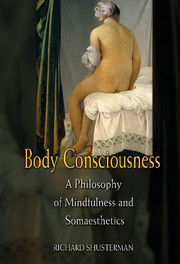Book contents
- Frontmatter
- Contents
- Preface
- Introduction
- 1 Somaesthetics and Care of the Self: The Case of Foucault
- 2 The Silent, Limping Body of Philosophy: Somatic Attention Deficit in Merleau-Ponty
- 3 Somatic Subjectivities and Somatic Subjugation: Simone de Beauvoir on Gender and Aging
- 4 Wittgenstein's Somaesthetics: Explanation and Melioration in Philosophy of Mind, Art, and Politics
- 5 Deeper into the Storm Center: The Somatic Philosophy of William James
- 6 Redeeming Somatic Reflection: John Dewey's Philosophy of Body-Mind
- Select Bibliography
- Index
Introduction
Published online by Cambridge University Press: 05 June 2012
- Frontmatter
- Contents
- Preface
- Introduction
- 1 Somaesthetics and Care of the Self: The Case of Foucault
- 2 The Silent, Limping Body of Philosophy: Somatic Attention Deficit in Merleau-Ponty
- 3 Somatic Subjectivities and Somatic Subjugation: Simone de Beauvoir on Gender and Aging
- 4 Wittgenstein's Somaesthetics: Explanation and Melioration in Philosophy of Mind, Art, and Politics
- 5 Deeper into the Storm Center: The Somatic Philosophy of William James
- 6 Redeeming Somatic Reflection: John Dewey's Philosophy of Body-Mind
- Select Bibliography
- Index
Summary
Body consciousness (a term of multiple meanings with widely ranging applications) forms the central focus of this book. In exploring various forms and levels of body consciousness and the diverse issues and theories through which twentieth-century philosophy has tried to explain the body's role in our experience, the book also advocates greater attention to somatic self-consciousness both in theory and in practice. I make the case for heightened somatic consciousness not simply by refuting influential philosophical arguments against the value of such consciousness, but also by outlining a systematic philosophical framework through which the different modes of somatic consciousness, somatic cultivation, and somatic understanding can be better integrated and thus more effectively achieved.
That disciplinary framework, somaesthetics, is explained in the book's first chapter, and its concepts and principles continue to shape my subsequent arguments. For the moment, we can briefly describe somaesthetics as concerned with the critical study and meliorative cultivation of how we experience and use the living body (or soma) as a site of sensory appreciation (aesthesis) and creative self-fashioning. Somaesthetics is thus a discipline that comprises both theory and practice (the latter clearly implied in its idea of meliorative cultivation). The term “soma” indicates a living, feeling, sentient body rather than a mere physical body that could be devoid of life and sensation, while the “aesthetic” in somaesthetics has the dual role of emphasizing the soma's perceptual role (whose embodied intentionality contradicts the body/mind dichotomy) and its aesthetic uses both in stylizing one's self and in appreciating the aesthetic qualities of other selves and things.
- Type
- Chapter
- Information
- Body ConsciousnessA Philosophy of Mindfulness and Somaesthetics, pp. 1 - 14Publisher: Cambridge University PressPrint publication year: 2008

